Spring is here and many people are getting excited about starting their garden. Maybe a little too excited, if there isn’t any preparation to protect the plants from frost.
With an unpredictable climate, a damaging frost could ruin your entire garden, if you aren’t prepared.
So, I have compiled a list of ways you could help protect your garden from frost for early gardens. But first – what actually is frost?
What is Frost?
Frost is when water vapor in the air has deposited as ice on a surface. It typically develops when the night is clear and calm, and the temperature is at or below freezing at ground level. Your thermometer may read above freezing, but it’s the temperature on the surface that matters.
Frost disrupts the fluids in the plant and will in turn deprive the plant’s tissue of necessary water. It won’t necessarily kill the plants entirely. But, expect at least some damage.
Related: How Does This Man Grow Oranges in Nebraska’s Cold Winter?
Choice of Plants
If you are determined to start your garden before the threat of a late frost is gone, make sure to choose cold-hardy seeds and plants. There are a few that are known to tolerate a certain amount of short-term frost.
Take for example crocuses. They have the ability to push up through snow to start blooming. Other flowers that can survive a short-term cold period include grape hyacinths, narcissus, and pansies.
Edible cold-hearty plants examples include the following:
- Cabbage
- Carrots
- Broccoli
- Lettuce
- Chives
- Peas
- Leeks
- Spinach
- Radish
- Swiss Chard
- Brussel Sprouts
When choosing any plant or seed, pay attention to your agriculture zone map. This will show how a particular plant will do for the duration of a normal planting season in your area as well.
Related: The States with the Most Medicinal Plants. Do You Live in One of Them?
There also are some plants to avoid when planting early, because they are sensitive to the cold. They include the following:
- Flowers and plants – fuchsia, begonias, geraniums, impatiens, and succulents.
- Edible options – tomatoes, citrus trees, pumpkins, cucumber, corn, sweet potatoes, peppers, and okra
- Spring – blooming trees and shrubs – azalea, cherry, and rhododendron
- Perennials – caladium, elephant ear, canna, and dahlia all can be dug up before the first frost in the fall and replanted in the spring after the last frost.
Again, check with the agricultural map to know which plants would do well in your area.
Find Frost-Resistant Areas
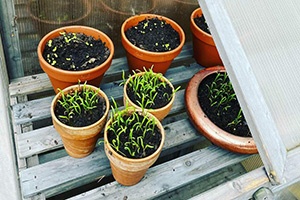 There are certain areas that are more resistant to frost than others. Cold air will seek the lowest ground first.
There are certain areas that are more resistant to frost than others. Cold air will seek the lowest ground first.
So, it’s better to plant seedlings and plants in elevated areas, if possible.
Other areas to consider are on benches, walls, fences, especially if they face the west or south.
It also helps if these structures are dark in color because they tend to absorb more heat during the day items lighter in color. This will help keep them slightly warmer during the night.
Surrounding shrubs can also help protect against a light frost.
Watch for Frost Pockets
Avoid planting seeds or a plant in a depression in the ground, because it acts as a magnet for frost. Cold air rushes to the depression and will linger there, creating a frost pocket.
Related: 8 Plants That You Need To Know How To Harvest Seeds From
Harden off Seedlings
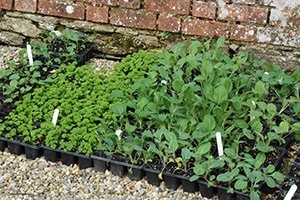 Hardening off a seed or seedling is when you gradually acclimate it to the outdoors, slowly exposing it to outside conditions.
Hardening off a seed or seedling is when you gradually acclimate it to the outdoors, slowly exposing it to outside conditions.
To do this, start the process about 2 weeks before you plan on transplanting it completely.
After the weather turns mild and above 45° F, you could put the seedlings outdoors for the day in a warm spot. Make sure it’s protected from the wind, and bring them back inside at night.
The acclimation process will strengthen the seedlings and prepare them for outside long-term.
Cover Plants at Night
Another thing you can do is cover the plants when a frost is predicted. It’s best to do this before the sun sets, so the absorbed heat from the day can be utilized.
There are several types of covers you can choose from, but make sure that it covers right down to the soil on all sides, without any openings. Stakes are also recommended to prevent the cover from blowing up or away.
Examples of these covers include the following:
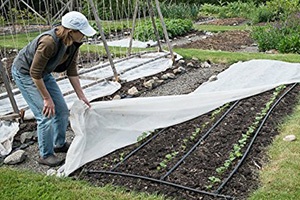 Blankets
Blankets- Sheets
- Drop Clothes
- Garden Blanket
- Frost Clothes
- Cardboard
- Towels
Just make sure the cover you choose is not resting on any plant. Remove the covers in the morning to prevent premature active growing. If there is another expected frost, cover them again at dusk.
Use Cloches to Cover Plants
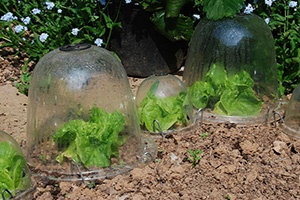
Cloches are removable dome or bell-shaped covers and come in handy to cover plants.
Just place them over the seedlings or plants before the sun sets, but not during the day.
Secure them, so the wind and critters can’t knock them over, and remove them again in the morning after the frost has a chance to thaw.
They can be made from multiple materials, and even made at home from the following:
- Milk Jugs
- Buckets
- Flower Pots
- Baskets
- Mason Jars
Warm the Plants with Plastic Jugs
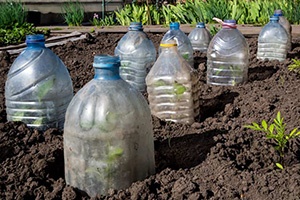 Use empty plastic water or milk jugs to help keep the plants warm at night.
Use empty plastic water or milk jugs to help keep the plants warm at night.
Simply fill each jug with water and place them outside in the sun for the day to soak up as much heat as naturally possible. Just before the sun sets, place them alongside your plants, then cover them along with the plants or seedlings.
The warm water will lose heat, but not as quickly as the ground does.
Related: How to Catch Fish with a Jug
Water Before the Frost
Yes, you read that right. It seems that it would damage the plants, but if you water the soil at sunset when a frost is expected, it can help protect them. The wet soil releases moisture at night into the air. This will help the temperature to rise around the plants.
Bring Your Potted Plants Inside
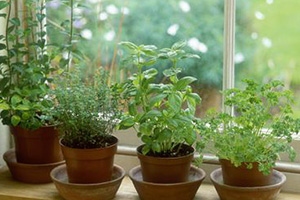 You might be wondering, why not just cover them? But, the roots of a potted plant are more sensitive to temperature changes, than those that are in the ground.
You might be wondering, why not just cover them? But, the roots of a potted plant are more sensitive to temperature changes, than those that are in the ground.
A word of caution though, check for pests and insects before bringing them inside.
Wrap Your Fruit Trees
The trunks of fruit trees should be wrapped with burlap or tree wrap in the fall, or spring when a frost is predicted. The thin and delicate bark on fruit trees is vulnerable to splitting (otherwise known as frost crack) if the temperatures change dramatically.
Just like our own bodies, multiple thin and relatively loose layers of the wrap work the best. And, make sure that the wrap extends from just below the lowest branch, all the way to the ground.
Fortunately, this wrap does not need to be taken on and off. As long as there is a threat of frost, leave it on.
As you can see, you have many options for protecting your plants and seedlings in an early garden. So, go ahead, get excited, because it’s spring!
You may also like:
10 Bugs You Should Never Kill In Your Garden
Backyard Projects That Might Get You Arrested (Video)
Microgreens: The Most Nutritious Indoor Food Source
Best Household Self-Defense Items You Probably Have In Your Home Right Now

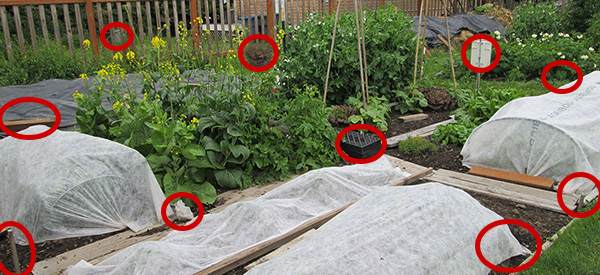
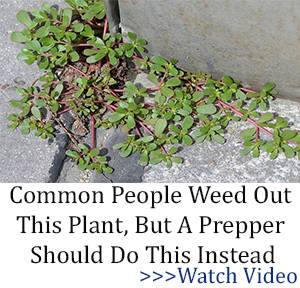




















About a cloache –
If you use say a 2 liter bottle with bottom cut off and place that in the ground to cover your plant, make sure you leave the cap off of the other end.
You can leave it like that even in the daytime.
Mini hoop houses work very well – you can make them out of PVC and cover with plastic. Anchor the perimeter with logs or rocks.
But not too tightly so you can still get air movement.
I do this annually with great success.
If I expect very cold temps, I fill 2 liter bottles with plain water and set them in the hoop house.
Just make sure there is about 3 feet or so in the arch to prevent plants from burning up on warm sunny days.
Opaque plastic sheeting is better than clear plastic sheeting. Just open the hoop house on very warm days to prevent excessive overheating.
About hardening off plants:
Plants have ‘mosaic cells’ on their leaves.
Air movement changes those cells to prevent water loss.
Note: if you must, you can place a 60 watt light bulb (plugged in) inside the hoop house. More of them depending on the size of the area (in cubic feet).
Same idea as in heating a dog house.
Well done, and very informative, but we live in zone 9A. We go from late fall to early spring. Frost happens, even freezes (it can get to 25 F here, but rarely). Even in ‘winter’ the sun is too hot to use anything clear to cover plants.
The major frost deterrent is used coffee ground. An inch around plants when nights get cold keeps the ground warm and chases off most frost. As fall progresses, 40% shade cloth at night works. In late spring, coffee ground have to be covered with mulch or they bake the roots. Then, they’re like cow manure, 4% nitrogen but with plenty of potassium.
Add to your list of frost resistant plants, Chimayo chilis. they thrive in cool weather. I’ve had them burn to the ground by freezes, but come back in late spring. Like all peppers, they do not like it too hot, but wow, do they bloom when it’s only in the 40s. niio
I was going to be a smartass and say, “Move to southern Texas to keep frost away!” Then came the Valentine’s Day storm and the four days following with high temps in the low twenties.
I wrapped my olive trees and my orange tree, but all of my other plants died. Before two weeks ago we figured that winter was over. It had been dry and warm for the most part. That’s what I get when I “assume” something.
Maybe for end of the season: When night time temps will get to or near frost, I always cover tomatoes and peppers with blankets. I remove them in the morning. This allows the tom and pepper plants to continue producing for as long as 2 or 3 more weeks.
Interesting one! Thanks..
hey! I agree with you cuz this mistake I have done in my garden and my All plants die from this mistake
Where are you gardening? I live in south Arizona not too far north of Tucson, and like Porter Improved tomatoes. Chimayo chilis do well in cooler temps. when in PA, we used to make a tent for the plants of translucent plastic. Down here, all it does is burn them. niio